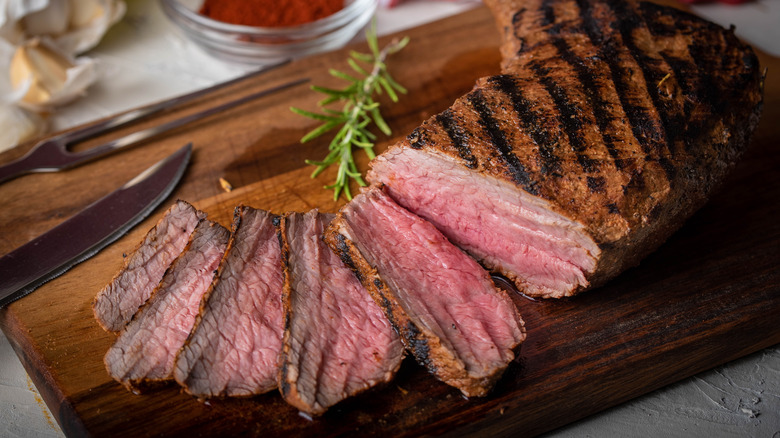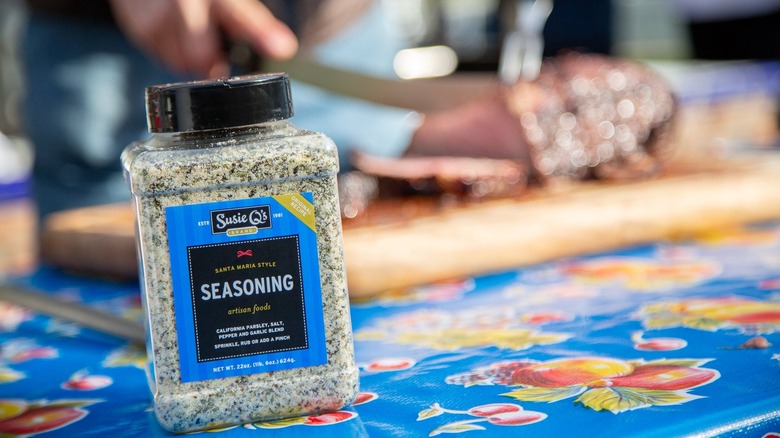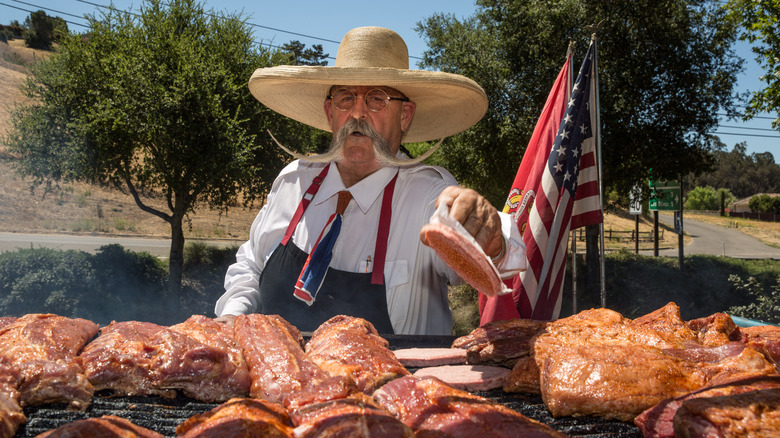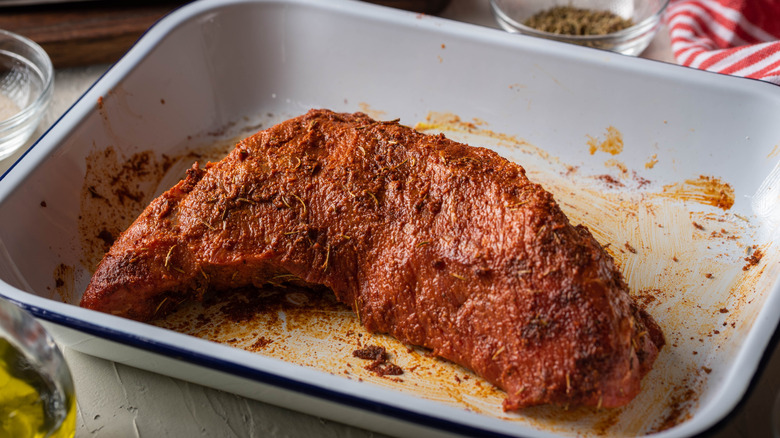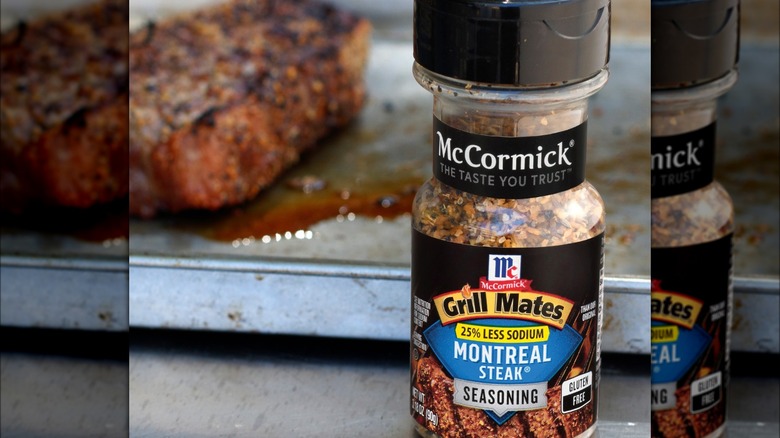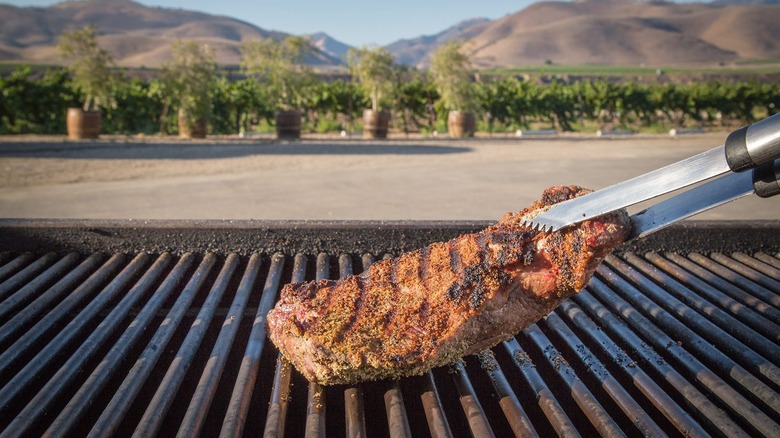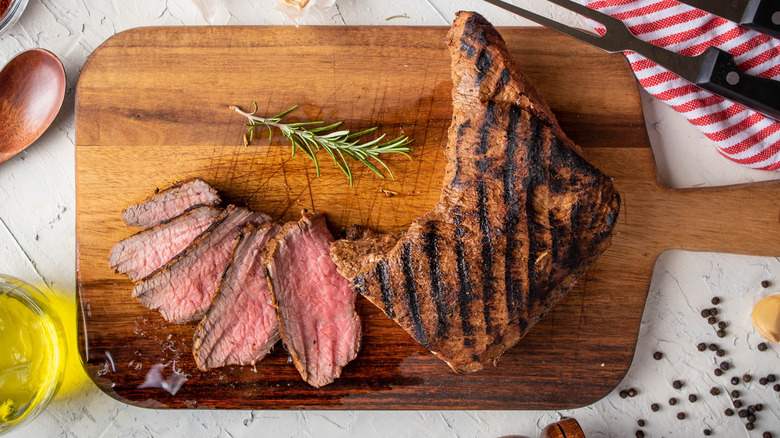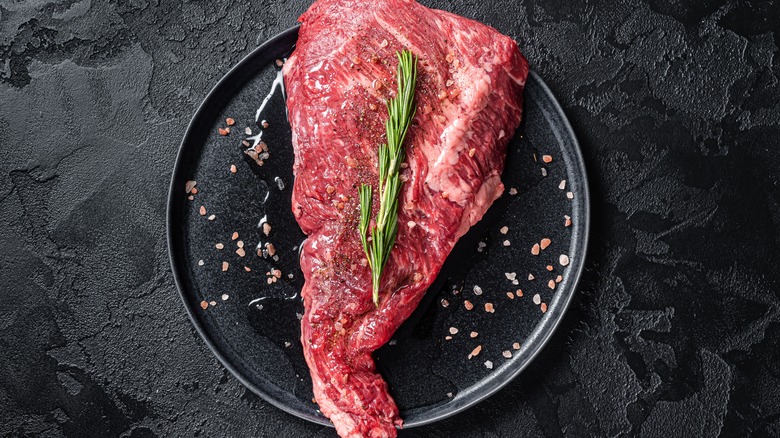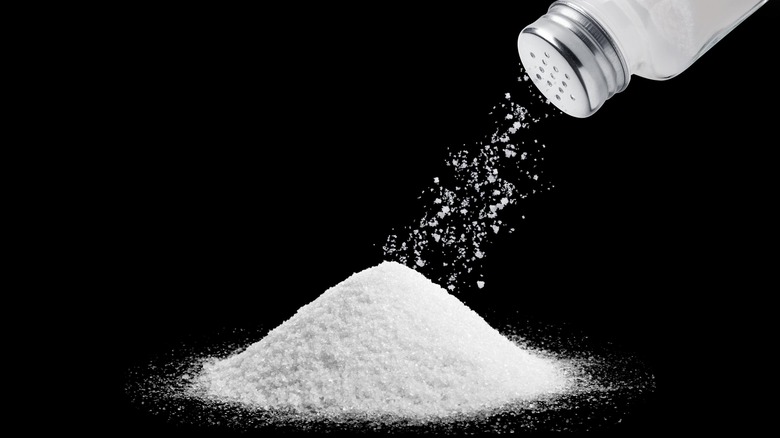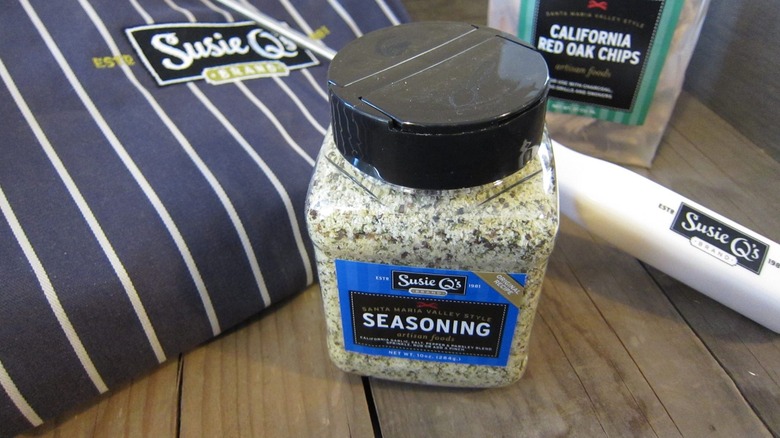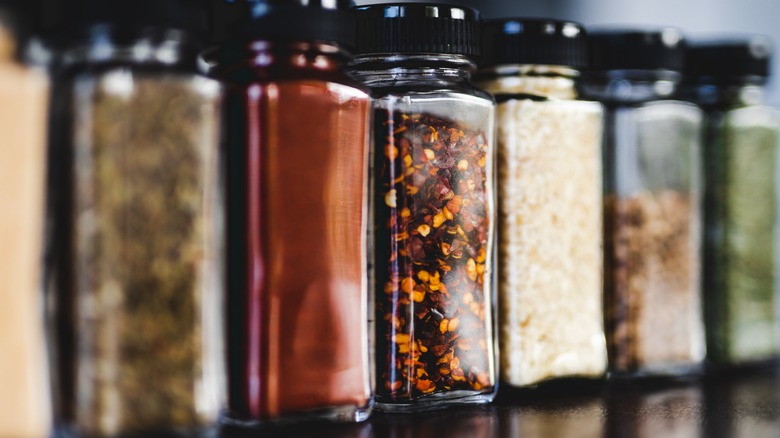What Is Santa Maria Seasoning And What Does It Taste Like?
Whether you're a home cook learning your way around the grill or just someone who's always interested in discovering a new regional cuisine, you need to know about Santa Maria seasoning. A West Coast favorite that's not very well known in other parts of the country, for some, Santa Maria seasoning is a necessity for smoking, grilling, and otherwise preparing various cuts of meat, most popularly, tri-tip steak.
To give you the low-down on this unique spice blend, we're relying on a mix of first-hand knowledge (while this writer may be based on the East Coast, pulling together some West Coast Santa Maria seasoning takes only a few ingredients that all are probably in your pantry or on your spice rack right now) and the insights from avid fans, enthusiastic smokers, and those that call the West Coast home. We researched the history and heritage of Santa Maria seasoning and dipped into barbecue-focused forums and Reddit threads as well.
What is Santa Maria seasoning?
Santa Maria seasoning is a spice and herb blend that hails from the West Coast, more specifically California. It takes its name from the Santa Maria Valley and the type of barbecue that was prepared in this area as far back as the mid-1800s. Today, Santa Maria barbecue is considered a regional favorite food that's available at many area restaurants and beloved by locals and visitors just lucky enough to discover it — and many credit the barbecue style's success to the Santa Maria seasoning used.
Santa Maria seasoning is used primarily for meats as a dry rub. Most traditionally, Santa Maria seasoning is used on tri-tip roast. This cut of meat is historically linked to the Santa Maria area, so if you're not familiar with it, don't worry; it's not always easy to find on the East Coast, but basically, it's a triangle-shaped cut from the bottom sirloin. It's a heavier cut, at about three to five pounds. In some areas of the country, a tri-tip is simply called a sirloin roast.
History of Santa Maria seasoning
Santa Maria seasoning is historically linked to California's Santa Maria Valley, which sits on the state's Central Coast in Santa Barbara County. It's known for its wine production today. However, where there are now wineries, historically, there were ranches and on those ranches were hungry ranchers and cowboys. As early as the 1800s, these individuals were cooking up large cuts of beef using a barbecue setup that relied on a red oak wood-filled pit; eventually, a special kind of grill that lowers and raises on a crank was added.
The barbecue tradition continued throughout the next century, and, over time, the tri-tip emerged as the cut of choice, as did a certain seasoning blend that would later come to be known as Santa Maria seasoning. Now, the regional barbecue style has become a point of pride for locals and a source of envy for those who've moved away or only had the pleasure of enjoying it on a brief visit.
How is Santa Maria seasoning made?
Santa Maria seasoning is relatively simple. However, while it doesn't have a long ingredient list, there are some variations on the recipe. Most seem to agree that the very basic and earliest version of Santa Maria seasoning included just salt, pepper, and garlic (garlic powder today, to make things easy). Today, though, many recipes also include some sort of sweetener, whether that be sugar or honey, as well as onion powder and parsley. The ratios of salt, pepper, and garlic also differ, with some using all three in one-to-one-to-one ratios, and others using more salt than pepper and garlic, or equal parts salt and garlic, but less pepper.
Some recipes also add extra ingredients for a more robust flavor profile, such as cayenne pepper, paprika, rosemary, or oregano, in smaller quantities, so as not to overpower the base of salt, pepper, and garlic. One of the most prominent brands of store-bought Santa Maria seasoning is Susie Q's, which relies on a simple base mixture of garlic, salt, pepper, and parsley.
Santa Maria seasoning vs. Montreal seasoning
Since Santa Maria seasoning is on the simpler side, you may think that it's pretty similar to other spice blends you may already have in your pantry, particularly spice blends that are also used to season steaks and beef. For example, store-bought Montreal seasoning starts with a salt, pepper, and garlic base, too, but then adds in other ingredients like onion and paprika. However, the ratios of the ingredients in Montreal seasoning do tend to differ from those found in Santa Maria seasoning.
Some Amazon users compared Montreal seasoning to Susie Q's Santa Maria seasoning and noted that Montreal steak seasoning is somewhat bolder than Santa Maria seasoning, with more pepper. In contrast, Santa Maria seasoning, while it does contain pepper, isn't quite so peppery, leaning more on the garlic for flavor. Some also noted that one is not necessarily better than the other — each one is intended for different cuts of meat. Santa Maria seasoning is often used on tri-tip, which is more like a roast. It's larger and has a lower fat content than other cuts of sirloin steak that could benefit more from Montreal seasoning's bolder flavor profile.
What does Santa Maria seasoning taste like?
What your Santa Maria seasoning tastes like will depend on whether you simply go basic with the primary mixture of salt, pepper, and garlic, or add in some of the extra ingredients that have become popular. If you go the basic route, you can expect the seasoning to taste primarily of garlic and pepper.
Despite the large proportions of salt often used, it's not overly salty as long as you don't have a heavy hand when you're seasoning your meat. If you add in extra, optional ingredients, like sugar, onion, rosemary, or paprika, you'll find that these appear as underlying notes of flavor, with the balanced pepper, salt, and garlic still taking center stage. When applied lightly as a steak rub or on something else that you plan on grilling or barbecuing over a flame, it enhances the flavors of the food without overpowering them. If you add in the sugar, it will caramelize and add additional flavor.
How to cook with Santa Maria seasoning
Just as is the case with any spice seasoning, Santa Maria seasoning is pretty versatile and you could use it on just about anything, in any setting, if you really wanted to. That said, it has some uses that are better than others.
If you're going to go the traditional route and you plan on applying your Santa Maria seasoning to tri-tip, use it as a dry rub and apply the seasoning to the raw cut of meat ahead of cooking (pat the meat dry with paper towels before seasoning). Dry rubs should be left to sit on the meat for at least 15 minutes, but you can let it sit longer, too, for better flavor. While there is a specific Santa Maria-style grill that's traditionally used to cook the seasoned tri-tip, you can use your regular grill to cook the meat, too. However, Santa Maria seasoning can be used in a variety of ways beyond this. Put it on other types of grilled meat or vegetables or add it to your chili, soups, sauces, or homemade salad dressings.
What type of meat is best with Santa Maria seasoning?
Traditionally, tri-tip is the meat of choice if you're going to be using Santa Maria seasoning and this cut of meat boasts historic connections to the Santa Maria Valley region of California. A butcher in the area popularized the cut in the 1950s and it became a favorite with families looking for something to barbecue that was on the smaller side, but could still feed multiple people. Prior to this, the cut was more likely to be turned into ground beef. If you've never had tri-tip before, it's tender and has a characteristic earthy, beefy flavor that pairs well with Santa Maria seasoning — but it can also be more expensive than your average sirloin steak.
If you're looking for the best application for Santa Maria seasoning and tri-tip isn't an option, alternatives include sirloin tips, round roasts, rump roasts, and chuck roasts.
When you might not want to use Santa Maria seasoning
Santa Maria seasoning is so versatile that there's not really a terrible time to use it. If you like the flavor, you could use it just about anywhere. After all, its base is the same blend of spices and seasonings that you would use in a large majority of savory recipes.
The only time you might want to stay clear of this seasoning is if you happen to be watching your sodium intake, particularly if you're buying the Santa Maria seasoning from the store rather than making it yourself, which enables you to control just how much salt you include. As an example, Scott's Santa Maria style seasoning, a popular pick with local fans, contains 12% of your daily recommended sodium intake in just a quarter of a teaspoon of seasoning (and you're going to need a lot more than a quarter of a teaspoon to cover a tri-tip).
Where to buy Santa Maria seasoning
If you live in certain areas of the United States (think West Coast or West Coast-adjacent), you can find this seasoning in the spice aisle at the grocery store. However, if you don't live in the region where Santa Maria seasoning is popular, you may have a little more trouble hunting it down in person. Luckily, you can purchase Santa Maria seasoning easily online, including from brands that fans endorse, such as Scott's and Susie Q's. However, do note that it's not exactly cheap and you'll be paying more than a dollar per ounce in some cases for a seasoning blend that you can easily make on your own, at home.
You can buy a 7-ounce bottle of Scott's Santa Maria Seasoning on Amazon for $12.69. Susie Q's Original Santa Maria Style Seasoning is available in 22-ounce containers on Amazon for $28.50. Kinder's Santa Maria with Cracked Peppers & Herbs sells on Amazon for $13.99 for a 7.6-ounce bottle. All prices were accurate as of the publication date of this article, but may change over time.
Nutritional information about Santa Maria seasoning
Since Santa Maria seasoning is just salt, pepper, garlic, and occasionally a few other spices and seasonings, there's not much to know regarding nutritional benefits or drawbacks. As far as benefits go, there really aren't any, and as far as drawbacks, the only thing you might consider would be whether or not you want to consume quite as much sodium as this seasoning blend contains.
For reference, Scott's Santa Maria style seasoning, with 290 milligrams of sodium per serving, contains 12% of your daily recommended sodium intake in just a quarter of a teaspoon. Susie Q's Santa Maria seasoning similarly contains 250 milligrams of sodium in a quarter of a teaspoon, or 10% of your daily recommended sodium intake. According to the Mayo Clinic, it's advised that teenagers and adults aged 14 and older eat less than 2,000–2,300 milligrams of sodium per day to reduce the risk of hypertension and heart disease.
How to store Santa Maria seasoning
In general, homemade dry rubs will last about six months if you keep them in a sealed container. However, Santa Maria seasoning isn't your average dry barbecue rub.
If you purchase the seasoning from the store, follow your chosen brand's recommendations for freshness and shelf life; some report that their seasoning will last up to a year when stored correctly in an airtight container in a cool, dark spot in your pantry. However, the individual ingredients in Santa Maria seasoning can last even longer on their own. For example, garlic powder will last two to three years before going bad with the proper storage, while salt will last up to five years. Ground pepper, unfortunately, does begin to lose its flavor after a few months. Because of this, if you really want the freshest Santa Maria seasoning possible, consider either purchasing it from the store or creating homemade batches of the seasoning in small quantities that you'll use within four months.
